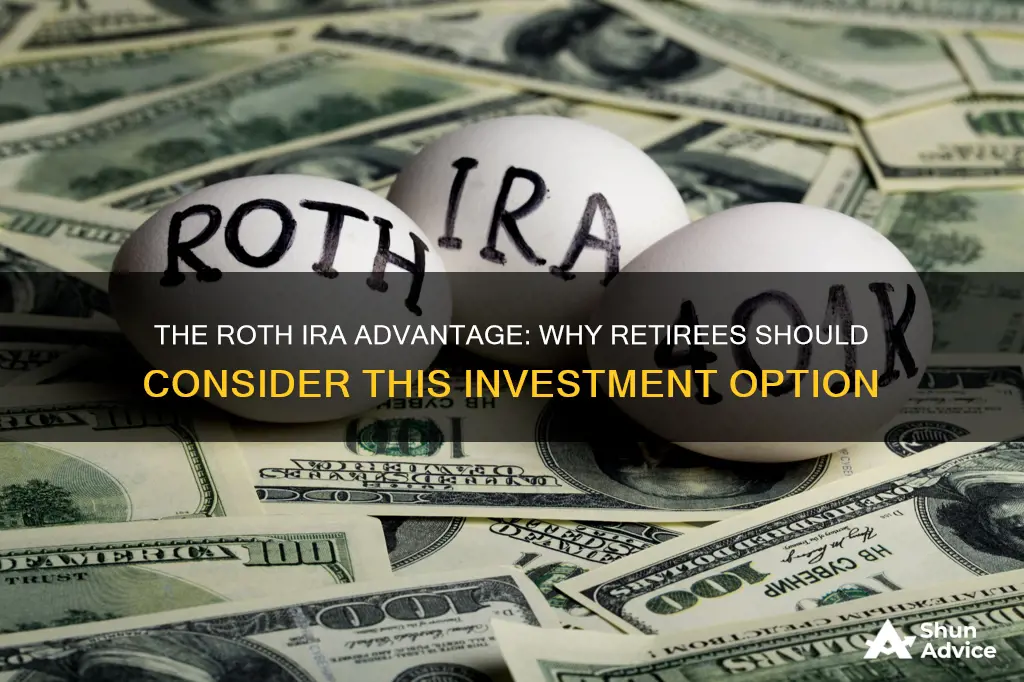
Retirees can benefit from investing in a Roth IRA, a special individual retirement account (IRA) that allows certain distributions or withdrawals to be made on a tax-free basis. Unlike traditional IRAs, Roth IRAs are funded with after-tax dollars, meaning there is no immediate tax benefit. However, this also means that qualified withdrawals are not taxed, as taxes have already been paid on the contributions. There is no age limit to open a Roth IRA, but there are income and contribution limits to consider. For example, in 2024, individuals with single tax-filing status cannot contribute to a Roth if their income exceeds $161,000. Additionally, the annual contribution limit for Roth IRAs is $7,000 in 2024, with individuals aged 50 and over able to deposit an additional $1,000 as a catch-up contribution. One of the main advantages of a Roth IRA is the flexibility it offers, as there is no requirement for when you must begin withdrawing money, and you can withdraw contributions at any time without penalty.
| Characteristics | Values |
|---|---|
| Income tax | You pay taxes on contributions, and then all future withdrawals are tax-free. |
| Tax-deductible | Contributions are not tax-deductible upfront. |
| Withdrawals | You can start taking tax-free withdrawals of both contributions and earnings once you turn 59 1/2, as long as you’ve had the account for at least five years. |
| Age limit | There is no age limit for making contributions. |
| Required minimum distributions (RMDs) | There are no RMDs during your lifetime. |
| Contribution limits | The maximum contribution for 2023 is $6,500, plus $1,000 if you’re 50 or older by the end of the year. The maximum contribution for 2024 is $7,000, plus the $1,000 catch-up contribution. |
| Income limits | Income must be below a certain level to be eligible to contribute to a Roth IRA. |
What You'll Learn

No age limit to open a Roth IRA
There is no age limit to open or contribute to a Roth IRA, so you can add funds to your account after creating it if you meet the qualifications. This means that even if you're close to retirement or already in retirement, opening a Roth IRA can still be a good idea.
Income requirements
There are, however, income and contribution limits that investors should be aware of. For example, in 2024, individuals with single tax-filing status cannot contribute to a Roth IRA if their income exceeds $161,000. For married couples filing jointly, the income threshold is $240,000 in 2024.
Tax benefits
The main advantage of a Roth IRA is that qualified distributions are not taxed, as you've already paid taxes on the contributions. In contrast, traditional IRAs are funded with pre-tax dollars, so you get an immediate tax deduction.
Age considerations
While there is no maximum age limit, there are some age considerations to keep in mind. For example, you'll need to have the account open for at least five years to take penalty-free withdrawals. Additionally, if you're approaching retirement and don't have many tax-free dollars invested, a Roth IRA could be a good option to boost your savings.
Passing funds to heirs
Another benefit of a Roth IRA is the ability to pass funds to your heirs tax-free. There are no required minimum distributions (RMDs) during your lifetime, so you can leave the entire account to your heirs if you don't need the money for living expenses.
Diversity Pays Dividends: Unlocking Performance Through Inclusion
You may want to see also

No requirement to withdraw money
One of the key benefits of a Roth IRA is that there is no requirement to withdraw money from the account during your lifetime. This is in contrast to a traditional IRA, which mandates required minimum distributions (RMDs) beginning at age 73 (or 75 from 2033 onwards). With a Roth IRA, you can leave the money in the account to continue earning interest until you die and then pass it on to your heirs. This makes it a great option for those who want to leave tax-free money to their children or grandchildren.
The lack of RMDs also means that you can better manage your tax liability during retirement. With a traditional IRA, you are forced to take distributions at a certain age, which may push you into a higher tax bracket. With a Roth IRA, you have more flexibility to decide when and how much you withdraw, allowing you to stagger distributions depending on your income from other sources.
Another advantage of the Roth IRA's lack of RMDs is that it can help your heirs keep more of the money you leave them. With traditional IRAs, beneficiaries are usually taxed on withdrawals, but with a Roth IRA, your heirs won't be taxed on distributions as long as they comply with the RMD rules.
The fact that there is no requirement to withdraw money from a Roth IRA also means that you can continue to contribute to the account as long as you are earning an income. This makes it a good option for semi-retirees or retirees who continue to work part-time or do occasional consulting or freelance work. As long as you are earning an income, you can keep adding to your Roth IRA and taking advantage of its tax benefits.
Overall, the lack of required minimum distributions is a significant advantage of a Roth IRA, offering retirees flexibility and the ability to leave tax-free money to their heirs.
Crude Oil: Invest Now?
You may want to see also

Tax-free withdrawals
One of the most significant advantages of a Roth IRA is that it allows for tax-free withdrawals in retirement. This means that, unlike with traditional IRAs, you are not taxed on the earnings your contributions have made over the years. This can result in considerable savings, as you are effectively paying taxes on your contributions at a lower rate than you would have paid upon withdrawal in retirement.
To benefit from tax-free withdrawals, you must meet certain conditions. Firstly, you can only withdraw contributions and earnings from your Roth IRA tax-free once you reach the age of 59½, and you must have held the account for at least five years. If you withdraw earnings before this time, you will likely be taxed and penalised. However, there are some exceptions to these rules. For example, you can take tax- and penalty-free withdrawals from your Roth IRA earnings before the age of 59½ if you use the money to buy, build, or rebuild a first home for yourself or a family member, for qualified higher education expenses, or if you become disabled.
Another benefit of a Roth IRA is that you are never required to take distributions from the account. This is in contrast to traditional IRAs, which mandate required minimum distributions (RMDs) beginning at age 73. With a Roth IRA, you can leave the entire account to your heirs, allowing you to pass on a stream of tax-free income to the next generation.
It is worth noting that, while there is no age limit for contributing to a Roth IRA, there are income and contribution limits that investors should be aware of. These limits depend on your tax filing status (single or married) and your income level. Additionally, you can only contribute to a Roth IRA if you have earned income, such as salaries, wages, tips, or bonuses, rather than unearned income, such as dividends, interest, or Social Security.
Savings Indirectly Matched with Investors
You may want to see also

No required minimum distributions
One of the most significant advantages of a Roth IRA is that, unlike traditional IRAs, there are no required minimum distributions (RMDs) during the account owner's lifetime. This means that as long as you are alive, you can leave your money in a Roth IRA without facing any IRS penalties. This feature makes Roth IRAs an excellent tool for building long-term wealth and leaving a financial legacy for your beneficiaries.
The absence of RMDs in Roth IRAs offers several benefits. Firstly, it allows for continued tax-free growth of your investments, as you are not required to withdraw funds and pay taxes on them. This can result in substantial savings over time. Secondly, it provides you with greater flexibility in managing your distributions. You can choose to leave the funds in the account to grow or withdraw them as needed, depending on your income from other sources, such as Social Security or other investments. This flexibility ensures that you can optimise your tax situation and maintain control over your financial strategy during retirement.
Additionally, the lack of RMDs in Roth IRAs can be advantageous for those who want to pass on their wealth to the next generation. With a Roth IRA, you can leave the entire account balance to your heirs, who will be able to access tax-free income. This feature is especially beneficial for those who wish to provide a stream of tax-free income to their children or grandchildren.
It is important to note that while there are no RMDs for the original owner of a Roth IRA, the distribution rules do change upon the owner's death. The specific withdrawal requirements depend on who inherits the Roth IRA funds. For example, a spouse can roll over the inherited funds into their own Roth IRA without any immediate RMDs, while non-spouse beneficiaries, such as children, must either withdraw the funds immediately or transfer them to an inherited Roth IRA, which has its own set of distribution rules.
Immaterial Labor: Why Invest?
You may want to see also

Income limits for contributions
The income limits for contributing to a Roth IRA depend on your tax-filing status and modified adjusted gross income (MAGI). Your MAGI is calculated by taking the adjusted gross income (AGI) from your tax return and adding back deductions for things like student loan interest, self-employment taxes, and higher education expenses.
For 2024, if you are filing as a single person, your MAGI must be under $161,000 to contribute to a Roth IRA. If you are married and filing jointly, your MAGI must be under $240,000. For 2023, the limits were $153,000 for single filers and $228,000 for married couples filing jointly.
If your MAGI is between $146,000 and $161,000 as a single filer, or between $230,000 and $240,000 if you are married filing jointly, your contribution is reduced. If your MAGI is higher than $161,000 for single filers or higher than $240,000 for those married filing jointly, you are not eligible to contribute.
The contribution limit for a Roth IRA is $7,000 in 2024 (or $8,000 if you are over 50). This is the cap even if you make more, up to the phase-out level.
It is important to note that the income limits and contribution limits for Roth IRAs change annually, so be sure to check the latest information before making your contribution.
Wealth Management: Helping Clients Build Investment Portfolios
You may want to see also







